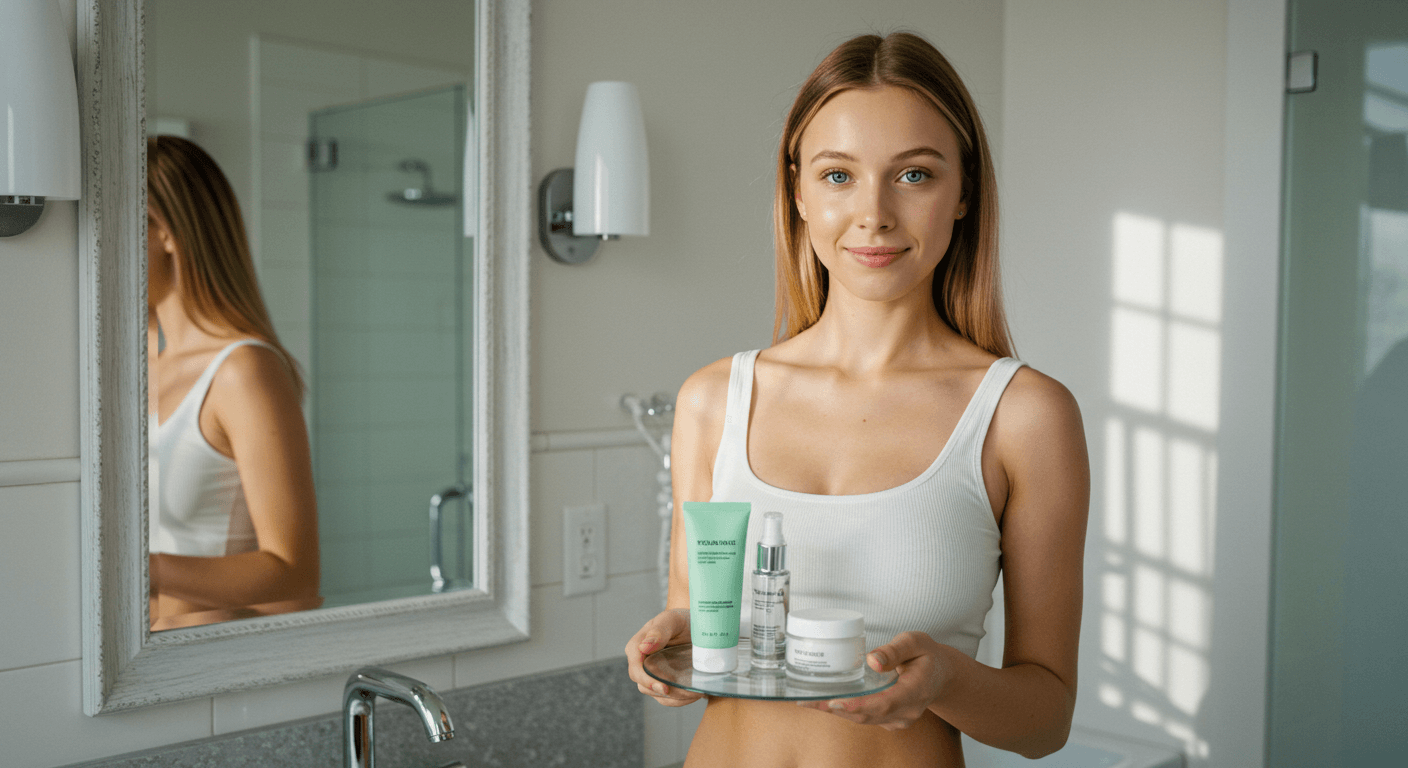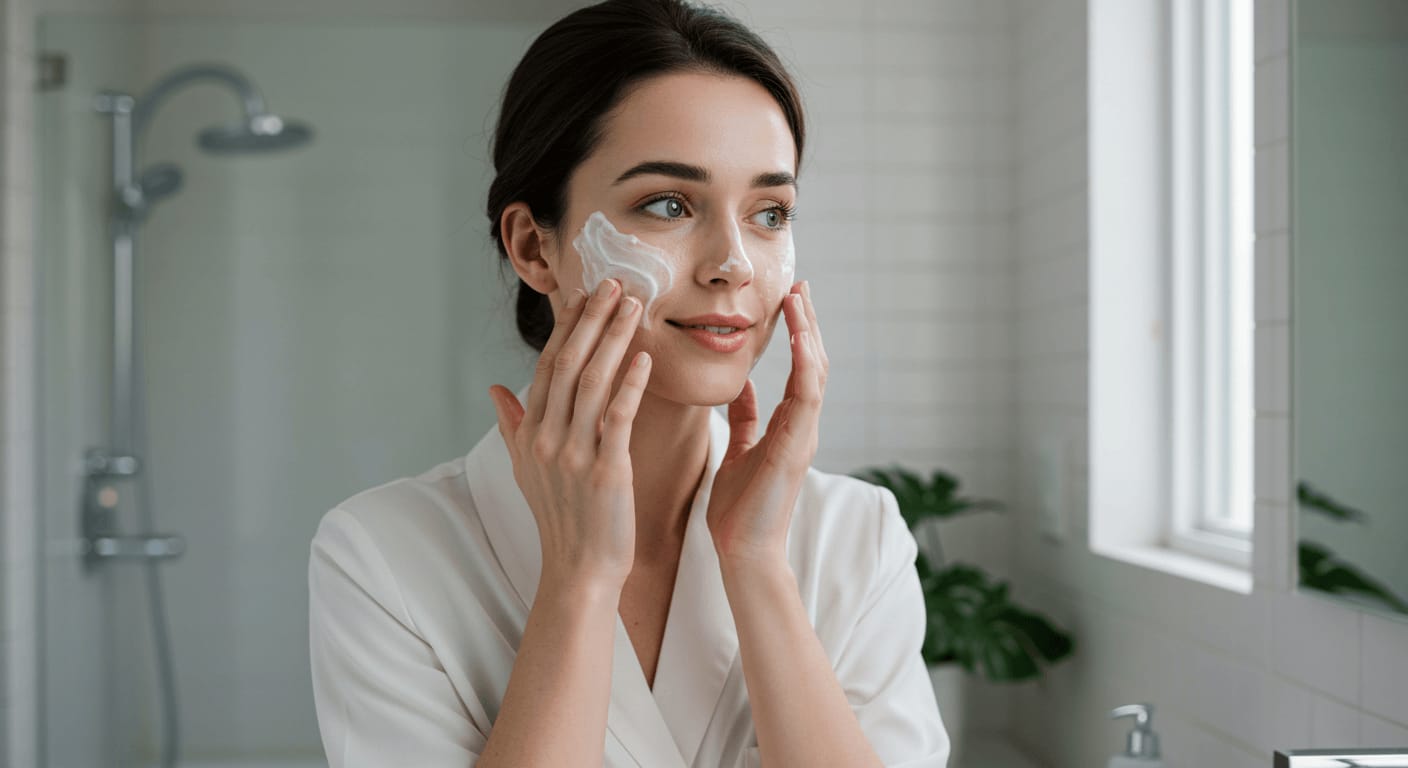Got dry skin? Don’t worry, you’re not alone! As winter approaches, dry air can leave your skin feeling flaky and tight. But fear not, with a solid skincare routine, you can lock in moisture and say goodbye to dryness. You’ll learn how to transform your skin from parched to plump and radiant, and it all starts with a few simple steps that you can easily incorporate into your daily routine to keep your skin healthy and glowing.
Table of Contents
Key Takeaways: Steps For A Skincare Routine To Combat Dry Skin
To combat dry skin, a consistent and well-planned skincare routine is imperative. Here are the key points to consider:
- Start with a gentle cleanser that effectively moisturizes and cleans the skin without stripping it of its natural oils.
- Use a toner that helps to balance the skin’s pH and tighten pores, reducing the appearance of dryness and irritation.
- Apply a serum rich in hyaluronic acid or ceramides to help lock in moisture and support the skin’s natural barrier function.
- Incorporate a moisturizer that provides long-lasting hydration and helps to repair dry, damaged skin, ideally containing emollients and humectants.
- Exfoliate regularly with a chemical or physical exfoliant to remove dead skin cells and improve skin texture, but avoid over-exfoliating, which can further dry out the skin.
- Protect the skin from environmental stressors, such as cold weather, wind, and dry air, by applying a protective moisturizer or face mask as needed.
- Maintain a consistent skincare routine and be patient, as it may take some time to see noticeable improvements in dry skin, and consider adjusting products or consulting a dermatologist if concerns persist.
Understanding Dry Skin
The truth is, dry skin can be a real nuisance, and it’s necessary to understand what you’re dealing with before you can tackle it. You see, dry skin, also known as xerosis, is a condition where your skin lacks moisture, leading to a rough, tight, and sometimes flaky texture. It’s a common problem that can affect anyone, regardless of their skin type or age. When your skin is dry, it can be more prone to irritation, itchiness, and even infections. To get a better grasp of dry skin, let’s take a look at the different types and factors that contribute to it.
The types of dry skin vary, and it’s good to know which one you have to address it properly.

Types of dry skin
You can have:
- Genetic dry skin: where your skin’s natural moisture barrier is impaired
- Environmental dry skin: caused by external factors like cold weather or harsh products
- Medical dry skin: related to underlying conditions like eczema or psoriasis
The following table summarizes the key characteristics of each type:
| Type of Dry Skin | Causes |
|---|---|
| Genetic | Impaired natural moisture barrier |
| Environmental | Cold weather, harsh products |
| Medical | Eczema, psoriasis |
| Seasonal | Dry air, low humidity |
| Product-induced | Harsh skincare products |
The most important thing to note is that each type of dry skin requires a different approach. After understanding the different types of dry skin, you can move on to learning about the factors that contribute to it.
Factors that contribute to dry skin
The reality is, there are many factors that can contribute to dry skin, and it’s good to be aware of them so you can take preventive measures. You should know that factors like harsh skincare products, cold weather, and low humidity can all strip your skin of its natural moisture. Here are some other factors to consider:
- Aging: as you get older, your skin’s natural moisture barrier weakens
- Medical conditions: certain conditions like diabetes or thyroid disorders can cause dry skin
- Nutritional deficiencies: lack of omega-3 fatty acids or vitamin D can lead to dry skin
The factors that contribute to dry skin can be complex and interrelated. After understanding these factors, you can start to make changes to your lifestyle and skincare routine to combat dry skin.
Similar to the factors that contribute to dry skin, your daily habits can also play a significant role in the health of your skin. The key is to be mindful of how your lifestyle choices affect your skin. Skin that is well-moisturized and protected from the elements is more resilient and less prone to dryness. Here are some additional factors to consider:
- Smoking: smoking can reduce blood flow to the skin, leading to dryness and premature aging
- Stress: high levels of stress can cause inflammation, which can dry out your skin
- Poor diet: a diet lacking necessary nutrients can lead to dry, dull skin
After making a few simple changes to your daily habits, you can start to notice a significant improvement in the health and appearance of your skin. skin that is healthy and well-moisturized is more radiant and glowing, and it’s less prone to irritation and infection.
Preparing for a Skincare Routine
One of the most significant steps in combating dry skin is to prepare your skin for a skincare routine. While you’re getting ready to start your journey to healthier skin, it’s vital to consider a few factors that will help you achieve your goals. You’ll need to assess your skin type, identify your skin concerns, and determine what products will work best for you. This preparation phase is vital in ensuring that you create a routine that is tailored to your specific skin needs.
As you begin to prepare, consider the following: you’ll need to invest in a few vital products, such as a moisturizer, cleanser, and exfoliant. You’ll also want to think about your lifestyle and how it may impact your skin, such as environmental factors like humidity and temperature. The key to a successful skincare routine is to find balance and be consistent, so take your time and don’t be afraid to experiment until you find what works best for you. The most important thing is to be patient and give your skin time to adjust to the new products and routine.

Tips for choosing the right products
While navigating the world of skincare, you’ll find that there are countless products available, each claiming to offer miraculous results. You’ll want to be cautious and do your research before making any purchases. Here are a few tips to keep in mind:
- Look for natural ingredients that are gentle on your skin
- Avoid harsh chemicals that can further dry out your skin
- Choose products that are Specifically designed for your skin type
The selection of products can be overwhelming, but by considering these factors, you’ll be well on your way to finding the perfect skincare routine for your dry skin. The key is to find products that work in harmony with your skin, rather than against it.
Setting realistic expectations
Routinely, you’ll find that creating a skincare routine is not a quick fix, but rather a long-term commitment to caring for your skin. You’ll need to be patient and consistent in your efforts, as results may take time to appear. Choosing the right products and sticking to your routine is vital in achieving healthy and glowing skin. As you commence on this journey, remember that it’s okay to make mistakes and that it’s a process to find what works best for you. The most important thing is to be kind to your skin and give it the care and attention it deserves, and with time, you’ll start to see positive changes in your skin.
Step-by-Step Skincare Routine
For a successful skincare routine to combat dry skin, you’ll want to follow a consistent regimen that nourishes and protects your skin. The following table outlines the key steps to include in your daily routine:
| Step | Description |
|---|---|
| 1. Cleanse | Use a gentle cleanser to remove dirt and impurities |
| 2. Exfoliate | Use a chemical exfoliant or physical exfoliant to remove dead skin cells |
| 3. Moisturize | Apply a rich moisturizer to lock in hydration |
By following these steps, you’ll be well on your way to soothing and hydrating your dry skin.
Step-by-step, you’ll want to tailor your routine to your individual skin type and concerns. Let’s break it down into morning and evening routines.

Morning routine for dry skin
Step-by-step, you’ll want to start your day by cleaning your face with a gentle cleanser, followed by a hydrating moisturizer to lock in moisture. Be sure to apply a broad-spectrum sunscreen with an SPF of at least 30 to protect your skin from harmful UV rays.
Evening routine for dry skin
While you sleep, your skin regenerates and repairs itself, so it’s important to give it the right tools to do so. You’ll want to remove your makeup and cleanse your face with a gentle cleanser, followed by a nourishing moisturizer to hydrate your skin.
Skincare is not just about preventing dryness, but also about treating existing dry patches. While you may be tempted to over-exfoliate or over-moisturize, be careful not to irritate your skin further. Instead, focus on gently and consistently caring for your skin, and you’ll be on your way to a glowing complexion.
Additional Tips and Tricks
Unlike other skincare routines, combating dry skin requires a bit more effort and dedication, but trust us, it’s worth it! You’ll want to make sure you’re using the right products and techniques to lock in moisture and keep your skin hydrated. Here are a few extra tips to keep in mind:
- Using gentle cleansers and avoiding harsh exfoliants
- Applying rich moisturizers and hydrating serums
- Getting enough sleep and staying hydrated
Thou shall see the difference in your skin once you start incorporating these tips into your daily routine, and your skin will thank you for it.

Exfoliation and moisturizing techniques
You’re probably wondering what the best ways are to exfoliate and moisturize your dry skin. Similar to other skincare routines, it’s all about finding the right balance and being gentle with your skin. In the matter of exfoliation, you’ll want to use a gentle exfoliant that won’t strip your skin of its natural oils. For moisturizing, look for rich and hydrating products that will lock in moisture and keep your skin soft and supple.
Yours is a skin type that will benefit from regular exfoliation and moisturizing, so make sure to incorporate these steps into your daily routine. You can also try using warm compresses or face masks to help open up your pores and allow your skin to absorb all the goodness. By following these tips, you’ll be on your way to achieving healthy and glowing skin in no time.
Protecting skin from environmental factors
Factors such as pollution, UV rays, and cold weather can all take a toll on your skin, so it’s vital to take steps to protect it. You can do this by:
- Wearing protective clothing and accessories, such as hats and gloves
- Using SPF moisturizers and sunscreens
- Avoiding harsh chemicals and irritating products
After taking these precautions, you’ll be able to enjoy the outdoors without worrying about the negative effects on your skin.
Moisturizing is just the first step in protecting your skin from environmental factors. You should also consider using antioxidants and vitamins to help combat free radicals and damage caused by the environment. Here are a few more tips to keep in mind:
- Using humidifiers to add moisture back into the air
- Avoiding extreme temperatures and harsh winds
- Getting enough rest and staying hydrated
After following these tips, you’ll be able to keep your skin healthy and protected from the negative effects of the environment.
Pros and Cons of Different Skincare Products
To navigate the world of skincare, you’ll need to consider the pros and cons of various products. When choosing a skincare routine to combat dry skin, it’s imperative to weigh the advantages and disadvantages of different products. The following table breaks down the pros and cons of popular skincare products:
| Product | Pros and Cons |
|---|---|
| Moisturizers | Hydrates and soothes dry skin, but can be greasy and comedogenic |
| Exfoliants | Removes dead skin cells and unclogs pores, but can be irritating and dry out skin |
| Serums | Delivers active ingredients deep into the skin, but can be expensive and have limited shelf life |
| Cleansers | Effectively cleans the skin without stripping it of its natural oils, but can be harsh and drying |
| Face masks | Provides an intense dose of hydration and nourishment, but can be messy and time-consuming |
You’ll notice that each product has its unique set of pros and cons, and it’s up to you to decide what works best for your skin type and concerns.
As you explore different skincare products, you’ll encounter various debates, including natural vs chemical-based products and drugstore vs high-end products. These debates can be overwhelming, but don’t worry, we’ve got you covered. Let’s investigate the details of these debates to help you make informed decisions about your skincare routine.

Natural vs chemical-based products
Now that you’re aware of the pros and cons of different skincare products, let’s talk about the natural vs chemical-based products debate. You’re probably wondering whether natural products are safer and more effective or if chemical-based products are more potent and fast-acting. Natural products are often gentler and less likely to cause irritation, but they can be less effective and more expensive. On the other hand, chemical-based products can be more effective and faster-acting, but they can also be harsher and more likely to cause irritation.
Natural products are often preferred by those with sensitive skin or who prefer a more holistic approach to skincare. However, it’s imperative to note that not all natural products are created equal, and some can be just as harsh as chemical-based products. You’ll need to read labels carefully and look for products that are certified organic or natural to ensure you’re getting a high-quality product.
Drugstore vs high-end products
Products like skincare creams and serums can be found at both drugstores and high-end retailers. You’re probably wondering whether high-end products are worth the investment or if drugstore products can provide similar results. High-end products often contain more advanced and potent ingredients, but they can be expensive and out of budget for many people. On the other hand, drugstore products can be more affordable and accessible, but they can also be less effective and contain more fillers.
Another key difference between drugstore and high-end products is the level of customization. High-end products often cater to specific skin types and concerns, while drugstore products can be more one-size-fits-all. However, some drugstore brands are now offering more advanced and targeted products that can rival high-end products in terms of quality and effectiveness. As you navigate the world of skincare, you’ll need to consider your budget, skin type, and concerns when deciding between drugstore and high-end products.
Another point to consider is that price doesn’t always equal quality. Some drugstore products can be just as effective as high-end products, and vice versa. You’ll need to do your research and read reviews to find the best products for your skin, regardless of the price point. By being informed and savvy, you can make the most of your skincare routine and achieve healthy, glowing skin without breaking the bank.
Common Mistakes to Avoid
Despite your best efforts, you may be making some mistakes in your skincare routine that are exacerbating your dry skin. One of the most common mistakes is over-exfoliating, which can strip your skin of its natural oils, leading to even drier skin. You may be tempted to exfoliate daily, but gentle exfoliation one to two times a week is usually enough. Another mistake is under-moisturizing, which can leave your skin feeling tight and dry. You need to find a balance between exfoliating and moisturizing to keep your skin healthy and hydrated.

Over-exfoliating and under-moisturizing
On the surface, it may seem like exfoliating is the key to getting rid of dry skin, but over-exfoliating can actually do more harm than good. When you exfoliate too much, you’re stripping your skin of its natural barrier, leaving it vulnerable to dryness and irritation. You should aim to exfoliate only when necessary, and always follow up with a rich moisturizer to lock in hydration. On the other hand, under-moisturizing can be just as damaging, as it can leave your skin feeling tight and dry. You need to find a moisturizer that provides long-lasting hydration and apply it regularly to keep your skin healthy.
Ignoring skin type and concerns
Skin care is not a one-size-fits-all approach, and ignoring your skin type and concerns can lead to a host of problems. Your skin is unique, with its own set of strengths and weaknesses, and you need to tailor your skincare routine to address its specific needs. If you have sensitive skin, you’ll want to avoid harsh products that can irritate your skin, while dry skin requires rich, nourishing products to lock in moisture.
It is necessary to take your skin type and concerns into account when creating your skincare routine. If you have acne-prone skin, you’ll want to look for products that are non-comedogenic and oil-free, while mature skin requires products that are rich in antioxidants and hydrating. By taking the time to understand your skin and its needs, you can create a skincare routine that is tailored to your unique skin type and concerns, and that will help you achieve the healthy, glowing skin you deserve.
Final Words
With this in mind, you’re now equipped with the knowledge to tackle dry skin head-on. You’ve learned the necessary steps to create a skincare routine that will leave your skin feeling soft, supple, and thoroughly pampered. By following these simple yet effective steps, you’ll be well on your way to achieving the glowing complexion you’ve always desired. As you begin on this skincare journey, don’t be afraid to experiment and find the products that work best for your unique skin type. And, if you’re looking for more expert advice, you can find plenty of helpful tips on How To Build a Skincare Routine for Dry, Dehydrated Skin, which offers a wealth of information to help you craft a personalized routine that addresses your specific skin concerns.
As you move forward with your newfound skincare savvy, you’ll start to notice a significant difference in the health and appearance of your skin. Your skin will thank you for the extra TLC, and you’ll be thrilled with the results. So, go ahead and give your skin the love it deserves – with a little patience and persistence, you’ll be enjoying radiant, hydrated skin in no time. You got this, and your skin will be forever grateful! With your newfound knowledge, you’re ready to take on the world, one skincare step at a time. Happy glowing, and don’t forget to keep your skin happy and healthy!
FAQ:
Q: What are the initial steps to follow for a skincare routine to combat dry skin?
A: To start a skincare routine for combating dry skin, begin by cleansing your face with a gentle, non-comedogenic cleanser that is suitable for your skin type. Use lukewarm water, as hot water can strip the skin of its natural oils, exacerbating dryness. Gently massage the cleanser onto your face and then rinse it off with lukewarm water. Pat dry your face with a towel instead of rubbing it vigorously, which can cause irritation and remove more of the skin’s natural moisture.
Q: How do I choose the right moisturizer for my dry skin?
A: Choosing the right moisturizer is a significant part of your skincare routine if you have dry skin. Look for a moisturizer that is rich in emollients and humectants. Emollients help fill gaps between skin cells, making your skin feel smooth, while humectants attract moisture from the air, locking it into your skin. Consider a moisturizer with natural ingredients like hyaluronic acid, ceramides, or niacinamide, which are known for their effectiveness in retaining moisture and repairing the skin barrier. Apply your moisturizer immediately after bathing or cleansing while your skin is still damp to help lock in moisture.
Q: What role does exfoliation play in a skincare routine for dry skin?
A: Exfoliation is an important step in any skincare routine, including those for dry skin, as it helps remove dead skin cells that can make the skin appear dull and flaky. However, individuals with dry skin should exfoliate with caution, as over-exfoliation can lead to further dryness and irritation. Use a gentle exfoliant containing alpha-hydroxy acids (AHAs) or beta-hydroxy acids (BHAs) one to three times a week, depending on your skin’s sensitivity and needs. Chemical exfoliants are often preferred over physical exfoliants for dry skin because they are less likely to cause irritation.
Q: How can I protect my skin from environmental factors that contribute to dryness?
A: Environmental factors such as cold weather, low humidity, and exposure to harsh winds can significantly contribute to dry skin. To protect your skin, apply a rich moisturizer or a barrier cream before going outside, especially in harsh weather conditions. Wearing protective clothing like scarves and gloves can also help shield your skin from the elements. Inside, using a humidifier can help maintain a moisture level in the air that is beneficial for your skin, especially during the dry winter months or in air-conditioned spaces.
Q: Are there any lifestyle changes that can help improve dry skin as part of a skincare routine?
A: Yes, making certain lifestyle adjustments can complement your skincare routine and help improve dry skin. Staying hydrated by drinking plenty of water is imperative for maintaining skin health. Avoid hot baths and showers, opting for warm water instead, and limit your bath time. Also, be mindful of the fabrics that come into contact with your skin; choose natural fibers like cotton over synthetic ones, which can irritate the skin. Additionally, managing stress through practices like meditation or exercise can help, as stress can exacerbate skin conditions, including dryness. A balanced diet rich in omega-3 fatty acids, vitamins, and minerals will also support your skin health from the inside out.
























0 Comments
Trackbacks/Pingbacks